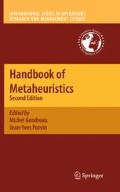Abstract
Metaheuristics are truly diverse in nature—under the overarching theme of performing operations to escape local optima, algorithms as different as ant colony optimization, tabu search, harmony search, and genetic algorithms have emerged. Due to the unique functionality of each type of metaheuristic, comparison of metaheuristics is in many ways more difficult than other algorithmic comparisons. In this chapter, we discuss techniques for meaningful comparison of metaheuristics. We discuss how to create and classify instances in a new testbed and how to make sure other researchers have access to the problems for future metaheuristic comparisons. Further, we discuss the disadvantages of large parameter sets and how to measure complicating parameter interactions in a metaheuristic’s parameter space. Last, we discuss how to compare metaheuristics in terms of both solution quality and runtime.
References
Ahuja, R., Orlin, J.: Use of representative operation counts in computational testing of algorithms. INFORMS J. Comput. 8(3), 318–330 (1996)
Archetti, C., Feillet, D., Hertz, A., Speranza, M.G.: The capacitated team orienteering and profitable tour problems. J. Oper. Res. Soc. 60(6), 831–842 (2009)
Bailey, D.: Twelve ways to fool the masses when giving performance results on parallel computers. Supercomput. Rev. 4(8), 54–55 (1991)
Bull, M., Smith, L., Pottage, L., Freeman, R.: Benchmarking Java against C and Fortran for scientific applications. In: ACM 2001 Java Grande/ISCOPE Conference, pp. 97–105. ACM, New York (2001)
Chao, I.M.: Algorithms and solutions to multi-level vehicle routing problems. Ph.D. thesis, University of Maryland, College Park, MD (1993)
Chen, S., Golden, B., Wasil, E.: The split delivery vehicle routing problem: applications, algorithms, test problems, and computational results. Networks 49, 318–329 (2007)
Christofides, N., Eilon, S.: An algorithm for the vehicle dispatching problem. Oper. Res. Q. 20(3), 309–318 (1969)
Coello, C.: Evolutionary multi-objective optimization: a historical view of the field. IEEE Comput. Intel. Mag. 1(1), 28–36 (2006)
Coy, S., Golden, B., Runger, G., Wasil, E.: Using experimental design to find effective parameter settings for heuristics. J. Heuristics 7(1), 77–97 (2001)
Deb, K., Agarwal, S.: Understanding interactions among genetic algorithm parameters. In: Foundations of Genetic Algorithms, pp. 265–286. Morgan Kauffman, San Mateo, CA (1998)
Dongarra, J.: Performance of various computers using standard linear equations software. Tech. rep., University of Tennessee (2009)
Dorigo, M., Stützle, T.: Ant Colony Optimization. MIT, Cambridge (2004)
Fischetti, M., Salazar González, J.J., Toth, P.: A branch-and-cut algorithm for the symmetric generalized traveling salesman problem. Oper. Res. 45(3), 378–394 (1997)
Gamvros, I., Golden, B., Raghavan, S.: The multilevel capacitated minimum spanning tree problem. INFORMS J. Comput. 18(3), 348–365 (2006)
Gendreau, M., Laporte, G., Semet, F.: A tabu search heuristic for the undirected selective travelling salesman problem. Eur. J. Oper. Res. 106(2–3), 539–545 (1998)
Glover, F.: Tabu search: a tutorial. Interfaces 20(4), 74–94 (1990)
Hartmann, S., Kolisch, R.: Experimental evaluation of state-of-the-art heuristics for the resource-constrained project scheduling problem. Eur. J. Oper. Res. 127(2), 394–407 (2000)
Hollasch, S.: Four-space visualization of 4d objects. Ph.D. thesis, Arizona State University, Tempe, Arizona (1991)
Jans, R., Degraeve, Z.: Meta-heuristics for dynamic lot sizing: a review and comparison of solution approaches. Eur. J. Oper. Res. 177(3), 1855–1875 (2007)
Li, F., Golden, B., Wasil, E.: Very large-scale vehicle routing: new test problems, algorithms, and results. Comput. Oper. Res. 32(5), 1165–1179 (2005)
Li, F., Golden, B., Wasil, E.: The open vehicle routing problem: algorithms, large-scale test problems, and computational results. Comput. Oper. Res. 34(10), 2918–2930 (2007)
Li, F., Golden, B., Wasil, E.: A record-to-record travel algorithm for solving the heterogeneous fleet vehicle routing problem. Comput. Oper. Res. 34(9), 2734–2742 (2007)
Michalewicz, Z.: Genetic Algorithms + Data Structures = Evolution Programs. Springer, New York (1996)
Montgomery, D.: Design and Analysis of Experiments. Wiley, New York (2006)
Nummela, J., Julstrom, B.: An effective genetic algorithm for the minimum-label spanning tree problem. In: Proceedings of the 8th Annual Conference on Genetic and Evolutionary Computation, pp. 553–557. ACM, New York (2006)
Paquete, L., Stützle, T.: Design and analysis of stochastic local search for the multiobjective traveling salesman problem. Comput. Oper. Res. 36(9), 2619–2631 (2009)
Plackett, R., Burman, J.: The design of optimum multifactorial experiments. Biometrika 33, 305–325 (1946)
Reinelt, G.: TSPLIB—a traveling salesman problem library. ORSA J. Comput. 3(4), 376–384 (1991)
Sawai, H., Kizu, S.: Parameter-free genetic algorithm inspired by “disparity theory of evolution”. In: Eiben, A., Bäck, T., Schoenauer, M., Schwefel H.P., (eds.) Parallel Problem Solving from Nature – PPSN V, LNCS, vol. 1498, pp. 702–711. Springer Berlin / Heidelberg (1998)
Silberholz, J., Golden, B.: The effective application of a new approach to the generalized orienteering problem. J. Heuristics 16(3), 393–415 (2010)
Wang, Q., Sun, X., Golden, B.L.: Using artificial neural networks to solve generalized orienteering problems. In: Dagli, C., Akay, M., Chen, C., Fernández, B., Ghosh J., (eds.) Intelligent Engineering Systems Through Artificial Neural Networks, vol. 6, pp. 1063–1068. ASME Press, New York (1996)
Xiong, Y., Golden, B., Wasil, E.: A one-parameter genetic algorithm for the minimum labeling spanning tree problem. IEEE Trans. Evol. Comput. 9(1), 55–60 (2005)
Xu, J., Kelly, J.: A network flow-based tabu search heuristic for the vehicle routing problem. Transp. Sci. 30(4), 379–393 (1996)
Author information
Authors and Affiliations
Corresponding authors
Editor information
Editors and Affiliations
Rights and permissions
Copyright information
© 2010 Springer Science+Business Media, LLC
About this chapter
Cite this chapter
Silberholz, J., Golden, B. (2010). Comparison of Metaheuristics. In: Gendreau, M., Potvin, JY. (eds) Handbook of Metaheuristics. International Series in Operations Research & Management Science, vol 146. Springer, Boston, MA. https://doi.org/10.1007/978-1-4419-1665-5_21
Download citation
DOI: https://doi.org/10.1007/978-1-4419-1665-5_21
Published:
Publisher Name: Springer, Boston, MA
Print ISBN: 978-1-4419-1663-1
Online ISBN: 978-1-4419-1665-5
eBook Packages: Mathematics and StatisticsMathematics and Statistics (R0)

